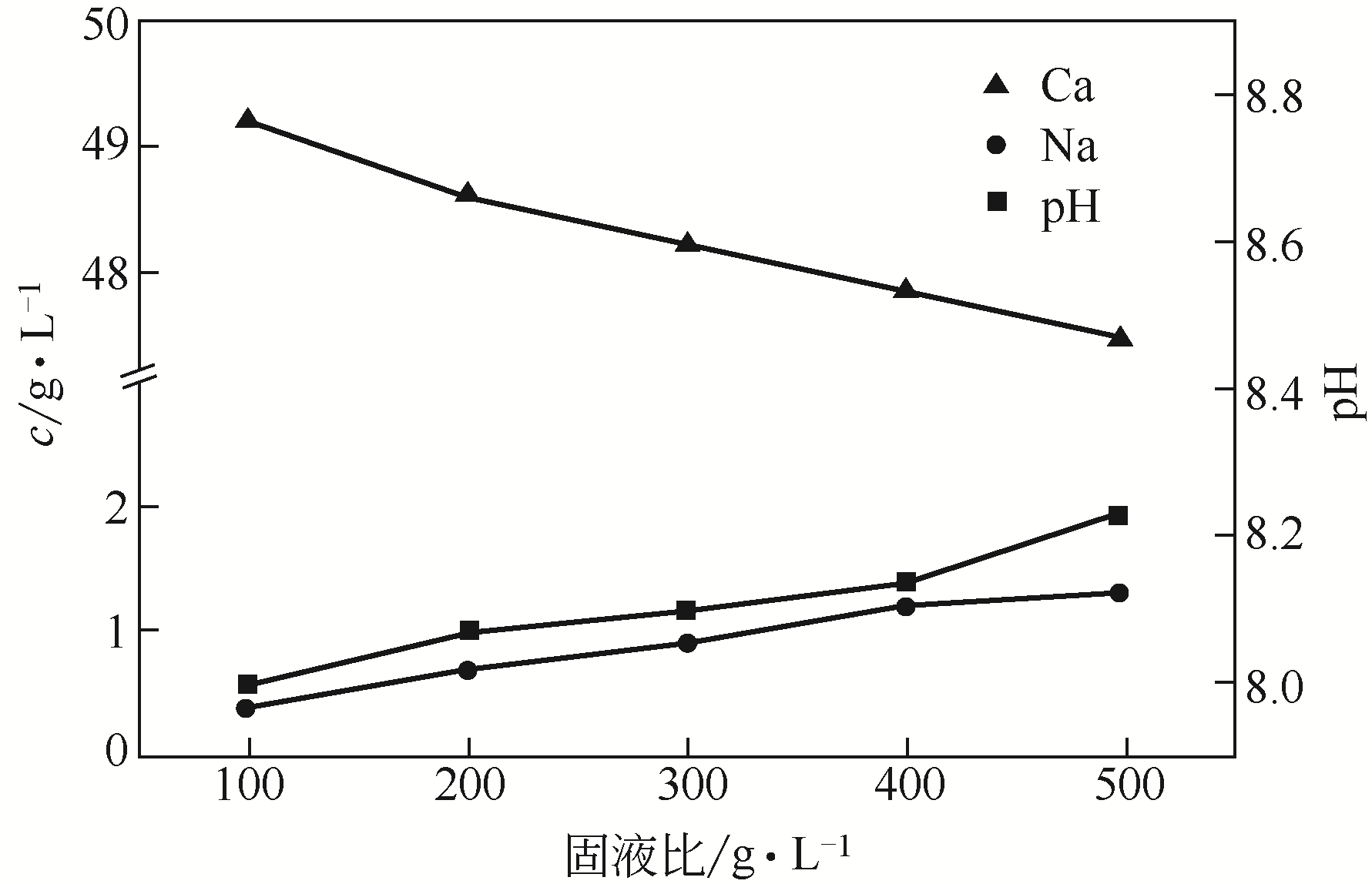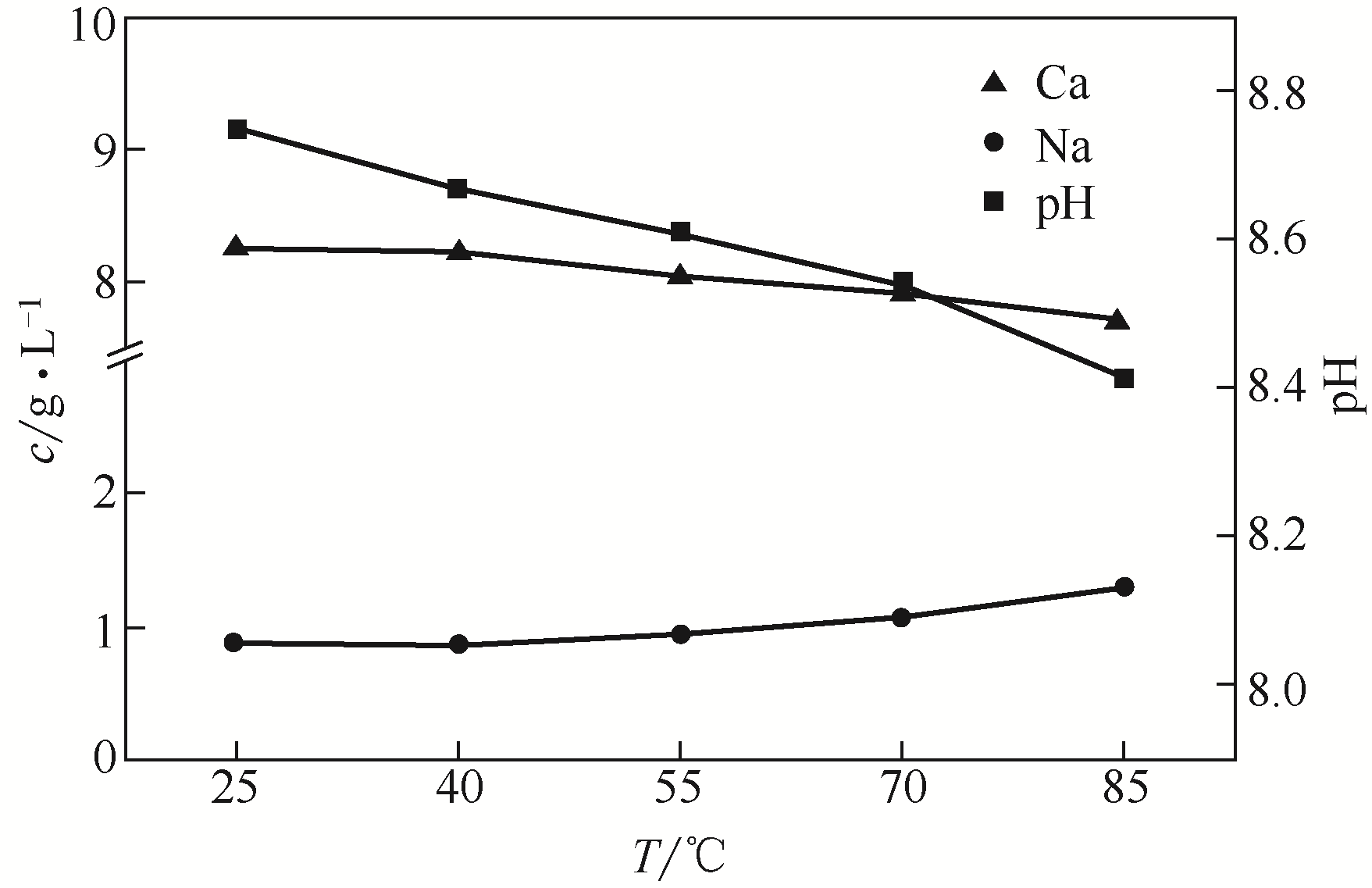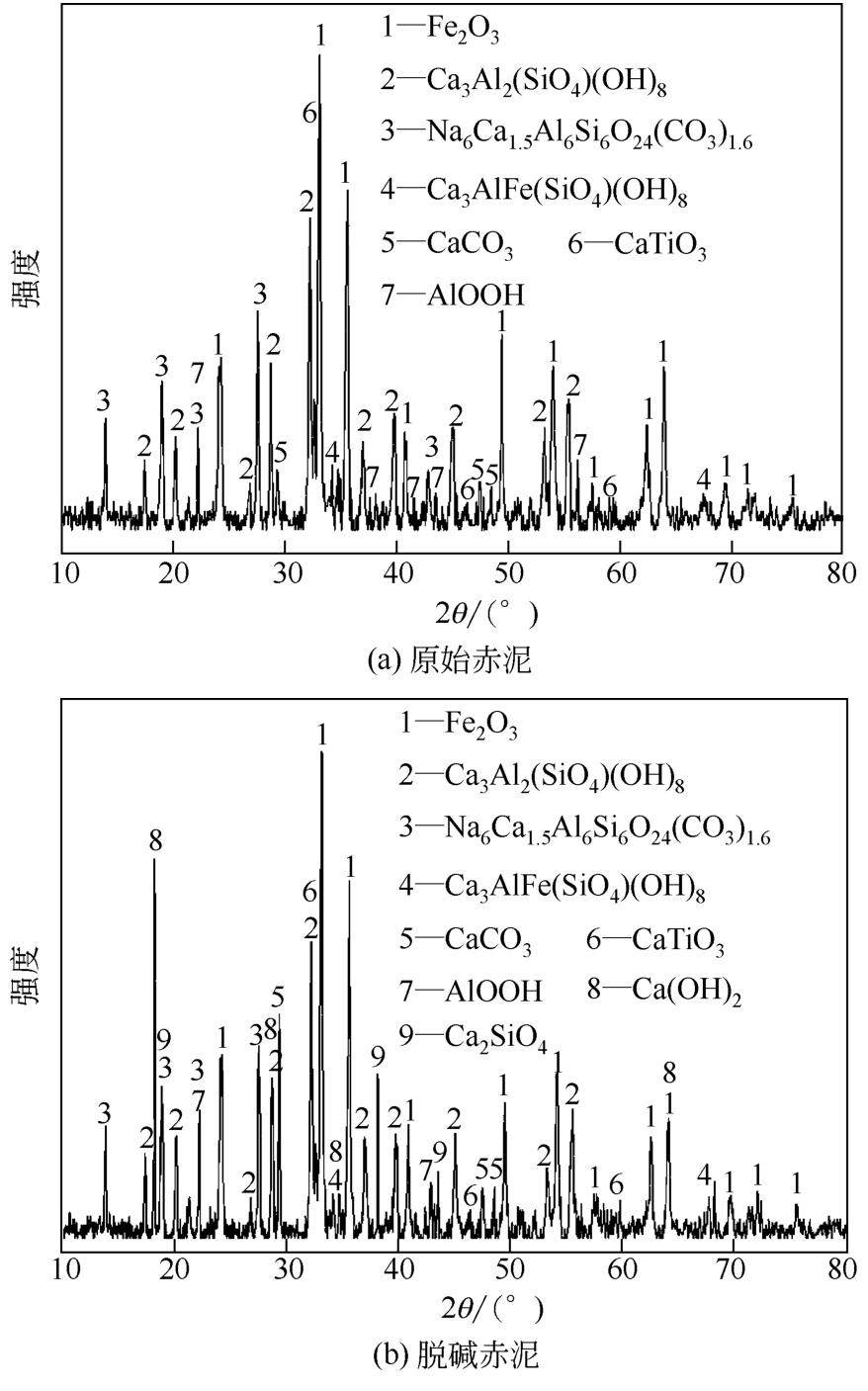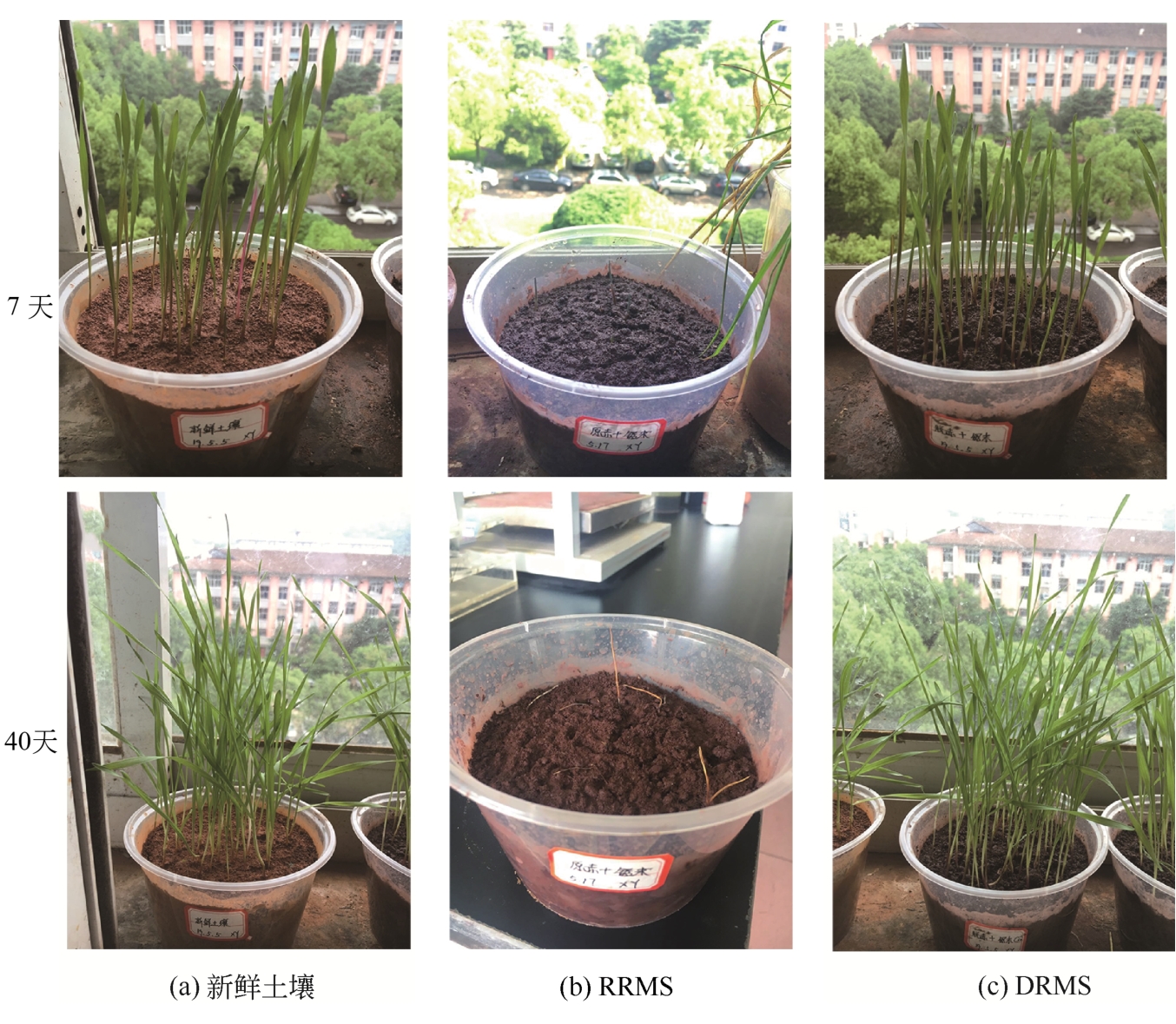Chemical Industry and Engineering Progress ›› 2021, Vol. 40 ›› Issue (5): 2909-2916.DOI: 10.16085/j.issn.1000-6613.2020-1207
• Resources and environmental engineering • Previous Articles Next Articles
Alkalinity regulation of red mud with recycled CaCl2
XING Yan( ), ZHANG Xuekai, ZHOU Kanggen(
), ZHANG Xuekai, ZHOU Kanggen( ), PENG Changhong
), PENG Changhong
- School of Metallurgy and Environment, Central South University, Changsha 410083, Hunan, China
-
Received:2020-06-29Online:2021-05-24Published:2021-05-06 -
Contact:ZHOU Kanggen
CaCl2回收液赤泥碱性调控
- 中南大学冶金与环境学院,湖南 长沙 410083
-
通讯作者:周康根 -
作者简介:幸艳(1995—),女,硕士研究生,研究方向为赤泥脱碱与土壤化协同处理技术。E-mail:xingyan@csu.edu.cn 。 -
基金资助:中南大学研究生自主探索创新项目(2020zzts482);中南大学中央高校基本科研业务费专项项目
CLC Number:
Cite this article
XING Yan, ZHANG Xuekai, ZHOU Kanggen, PENG Changhong. Alkalinity regulation of red mud with recycled CaCl2[J]. Chemical Industry and Engineering Progress, 2021, 40(5): 2909-2916.
幸艳, 张雪凯, 周康根, 彭长宏. CaCl2回收液赤泥碱性调控[J]. 化工进展, 2021, 40(5): 2909-2916.
share this article
Add to citation manager EndNote|Ris|BibTeX
URL: https://hgjz.cip.com.cn/EN/10.16085/j.issn.1000-6613.2020-1207
| 成分 | 质量分数/% |
|---|---|
| Fe | 19.45 |
| Al | 9.34 |
| Ca | 12 |
| Na | 7.41 |
| Si | 6.80 |
| Ti | 4.12 |
| 成分 | 质量分数/% |
|---|---|
| Fe | 19.45 |
| Al | 9.34 |
| Ca | 12 |
| Na | 7.41 |
| Si | 6.80 |
| Ti | 4.12 |
| 元素 | 浓度/mg·L-1 |
|---|---|
| Fe | 0.6 |
| Al | 8.2 |
| Ti | 0.6 |
| Ca | 49663 |
| Na | 7167 |
| Y | 0.2 |
| La | 2.6 |
| Ce | 1.9 |
| 元素 | 浓度/mg·L-1 |
|---|---|
| Fe | 0.6 |
| Al | 8.2 |
| Ti | 0.6 |
| Ca | 49663 |
| Na | 7167 |
| Y | 0.2 |
| La | 2.6 |
| Ce | 1.9 |
| 样品 | pH | EC/mS·cm-1 | 播种数 | 发芽数 | 发芽率/% |
|---|---|---|---|---|---|
| 原始赤泥 | 11.14 | 1.43 | — | — | — |
| 脱碱赤泥 | 8.05 | 0.64 | — | — | — |
| 新鲜土壤 | 5.12 | 0.10 | 50 | 42 | 84 |
| RRMS | 9.49 | 1.27 | 50 | 12 | 24 |
| DRMS | 8.54 | 0.35 | 50 | 46 | 92 |
| 样品 | pH | EC/mS·cm-1 | 播种数 | 发芽数 | 发芽率/% |
|---|---|---|---|---|---|
| 原始赤泥 | 11.14 | 1.43 | — | — | — |
| 脱碱赤泥 | 8.05 | 0.64 | — | — | — |
| 新鲜土壤 | 5.12 | 0.10 | 50 | 42 | 84 |
| RRMS | 9.49 | 1.27 | 50 | 12 | 24 |
| DRMS | 8.54 | 0.35 | 50 | 46 | 92 |
| 1 | 李彬, 张宝华, 宁平, 等. 赤泥资源化利用和安全处理现状与展望[J]. 化工进展, 2018, 37(2): 714-723. |
| LI Bin, ZHANG Baohua, NING Ping, et al. Present status and prospect of red mud resource utilization and safety treatment[J]. Chemical Industry and Engineering Progress, 2018, 37(2): 714-723. | |
| 2 | 薛生国, 吴雪娥, 黄玲, 等. 赤泥土壤化处置技术研究进展[J]. 矿山工程, 2015(3): 13-18. |
| XUE Shengguo, WU Xue'e, HUANG Ling, et al. Research advance on soil formation of bauxite residue[J]. Mine Engineering, 2015(3): 13-18. | |
| 3 | ZHANG Xuekai, ZHOU Kanggen, WU Yehuizi, et al. Separation and recovery of iron and scandium from acid leaching solution of red mud using D201 resin[J]. Journal of Rare Earths, 2020, 38(12): 1322-1329. |
| 4 | XUE Shengguo, WU Yujun, LI Yiwei, et al. Industrial wastes applications for alkalinity regulation in bauxite residue: a comprehensive review[J]. Journal of Central South University, 2019, 26(2): 268-288. |
| 5 | LI Yiwei, JIANG Jun, XUE Shengguo, et al. Effect of ammonium chloride on leaching behavior of alkaline anion and sodium ion in bauxite residue[J]. Transactions of Nonferrous Metals Society of China, 2018, 28(10): 2125-2134. |
| 6 |
POWER G, GRÄFE M, KLAUBER C. Bauxite residue issues: ( ): Current management, disposal and storage practices[J]. Hydrometallurgy, 2011, 108(1/2): 33-45. ): Current management, disposal and storage practices[J]. Hydrometallurgy, 2011, 108(1/2): 33-45.
|
| 7 | 王宇斌, 朱新锋, 张乐观, 等. 赤泥去除高浓度含磷废水[J]. 化工进展, 2010, 29(9): 1771-1774. |
| WANG Yubin, ZHU Xinfeng, ZHANG Leguan, et al. Adsorption removal of high concentration phosphorus wastewater using red mud[J]. Chemical Industry and Engineering Progress, 2010, 29(9): 1771-1774. | |
| 8 | ARINO M D, KATSIOTIS M, GIANNAKOPOULOS G, et al. Low-carbon footprint cements incorporating high volumes of bauxite residue[C]//The International Committee for Study of Bauxite, Alumina & Aluminium (ICSOBA), 2017. |
| 9 | PONTIKES Y, ANGELOPOULOS G N. Bauxite residue in cement and cementitious applications: current status and a possible way forward[J]. Resources Conservation and Recycling, 2013, 73: 53-63. |
| 10 | KIM Youngjae, Youngmin LEE, KIM Minseuk, et al. Preparation of high porosity bricks by utilizing red mud and mine tailing[J]. Journal of Cleaner Production, 2019, 207: 490-497. |
| 11 | MANDAL A K, VERMA H R, SINHA O P. Utilization of aluminum plant’s waste for production of insulation bricks[J]. Journal of Cleaner Production, 2017, 162: 949-957. |
| 12 | MUKIZA E, ZHANG L L, LIU X M, et al. Utilization of red mud in road base and subgrade materials: a review[J]. Resources, Conservation and Recycling, 2019, 141: 187-199. |
| 13 | ZHANG Xuekai, ZHOU Kanggen, LEI Qingyuan, et al. Stripping of Fe(Ⅲ) from Aliquat 336 by NaH2PO4: implication for rare-earth elements recovery from red mud[J]. Separation Science and Technology, 2021, 56(2): 301-309. |
| 14 | ZHANG Xuekai, ZHOU Kanggen, LEI Qingyuan, et al. Integration of resource recycling with de-alkalization for bauxite residue treatment[J]. Hydrometallurgy, 2020, 192: 105263. |
| 15 | NARAYANAN R P, KAZANTZIS N K, EMMERT M H. Selective process steps for the recovery of scandium from Jamaican bauxite residue (red mud)[J]. ACS Sustainable Chemistry & Engineering, 2018, 6(1): 1478-1488. |
| 16 | ZHANG Xuekai, ZHOU Kanggen, CHEN Wei, et al. Recovery of iron and rare earth elements from red mud through an acid leaching-stepwise extraction approach[J]. Journal of Central South University, 2019, 26(2): 458-466. |
| 17 | URÍK M, BUJDOŠ M, MILOVÁ-ŽIAKOVÁ B, et al. Aluminium leaching from red mud by Filamentous fungi[J]. Journal of Inorganic Biochemistry, 2015, 152: 154-159. |
| 18 | ZENG Hua, Fei LYU, HU Guangyan, et al. Dealkalization of bauxite residue through acid neutralization and its revegetation potential[J]. JOM, 2020, 72(1): 319-325. |
| 19 | PULFORD I D, HARGREAVES J S J, ĎURIŠOVÁ J, et al. Carbonised red mud—A new water treatment product made from a waste material[J]. Journal of Environmental Management, 2012, 100: 59-64. |
| 20 | 吕常胜, 王家伟, 贾永真, 等. 赤泥加入量对赤泥烧结砖的影响[J]. 安全与环境学报, 2013, 13(4): 98-102. |
| Changsheng LYU, WANG Jiawei, JIA Yongzhen, et al. Effects of red mud content on the sintered red mud bricks[J]. Journal of Safety and Environment, 2013, 13(4): 98-102. | |
| 21 | KUMPIENE J, LAGERKVIST A, MAURICE C. Stabilization of Pb- and Cu-contaminated soil using coal fly ash and peat[J]. Environmental Pollution, 2007, 145(1): 365-373. |
| 22 | OJEKANMI A A, CHANG S X. Soil quality assessment for peat-mineral mix cover soil used in oil sands reclamation[J]. Journal of Environmental Quality, 2014, 43(5): 1566-1575. |
| 23 | XUE Shengguo, ZHU Feng, KONG Xiangfeng, et al. A review of the characterization and revegetation of bauxite residues (red mud)[J]. Environmental Science and Pollution Research, 2016, 23(2): 1120-1132. |
| 24 | SHI Ben, QU Yang, LI Hui. Gypsum alleviated hydroxyl radical-mediated oxidative damages caused by alkaline bauxite residue in leaves of Atriplex canescens[J]. Ecological Engineering, 2017, 98: 166-171. |
| 25 | COURTNEY R G, TIMPSON J P. Reclamation of fine fraction bauxite processing residue (red mud) amended with coarse fraction residue and gypsum[J]. Water, Air, and Soil Pollution, 2005, 164(1-4): 91-102. |
| 26 | ZHU Feng, HOU Jingtao, XUE Shengguo, et al. Vermicompost and gypsum amendments improve aggregate formation in bauxite residue[J]. Land Degradation & Development, 2017, 28(7): 2109-2120. |
| 27 | DANIELS W, EVANYLO G, NAGLE S, et al. Effects of biosolids loading rate and sawdust additions on row crop yield and nitrate leaching potentials in Virginia sand and gravel mine reclamation[J]. Journal American Society of Mining and Reclamation, 2001(1): 399-406. |
| 28 | LIU Zhaobo, LI Hongxu, HUANG Mengmeng, et al. Effects of cooling method on removal of sodium from active roasting red mud based on water leaching[J]. Hydrometallurgy, 2017, 167: 92-100. |
| 29 | RAI S, WASEWAR K L, AGNIHOTRI A. Treatment of alumina refinery waste (red mud) through neutralization techniques: a review[J]. Waste Management & Research, 2017, 35(6): 563-580. |
| 30 | LI Xiaofei, YE Yuzhen, XUE Shengguo, et al. Leaching optimization and dissolution behavior of alkaline anions in bauxite residue[J]. Transactions of Nonferrous Metals Society of China, 2018, 28(6): 1248-1255. |
| 31 | ZHU Xiaobo, LI Wang, GUAN Xuemao. An active dealkalization of red mud with roasting and water leaching[J]. Journal of Hazardous Materials, 2015, 286: 85-91. |
| 32 | BORRA C R, BLANPAIN B, PONTIKES Y, et al. Recovery of rare earths and other valuable metals from bauxite residue (red mud): a review[J]. Journal of Sustainable Metallurgy, 2016, 2(4): 365-386. |
| 33 | 薛生国, 李晓飞, 孔祥峰, 等. 赤泥碱性调控研究进展[J]. 环境科学学报, 2017, 37(8): 2815-2828. |
| XUE Shengguo, LI Xiaofei, KONG Xiangfeng, et al. Alkaline regulation of bauxite residue: a comprehensive review[J]. Acta Scientiae Circumstantiae, 2017, 37(8): 2815-2828. | |
| 34 | CUSACK P B, HEALY M G, RYAN P C, et al. Enhancement of bauxite residue as a low-cost adsorbent for phosphorus in aqueous solution, using seawater and gypsum treatments[J]. Journal of Cleaner Production, 2018, 179: 217-224. |
| 35 | KISHIDA M, HARATO T, TOKORO C, et al. In situ remediation of bauxite residue by sulfuric acid leaching and bipolar-membrane electrodialysis[J]. Hydrometallurgy, 2017, 170: 58-67. |
| 36 | RAI S, WASEWAR K L, LATAYE D H, et al. Neutralization of red mud with pickling waste liquor using Taguchi’s design of experimental methodology[J]. Waste Management & Research, 2012, 30(9): 922-930. |
| 37 | WONG J W C, HO G E. Use of waste gypsum in the revegetation on red mud deposits: a greenhouse study[J]. Waste Management & Research, 1993, 11(3): 249-256. |
| 38 | CLARK M W, JOHNSTON M, REICHELT-BRUSHETT A J. Comparison of several different neutralisations to a bauxite refinery residue: potential effectiveness environmental ameliorants[J]. Applied Geochemistry, 2015, 56: 1-10. |
| 39 | 饶轶晟, 王凤霞. 磷石膏资源化利用途径及展望[J]. 化工矿物与加工, 2020, 49(8): 30-33. |
| RAO Yisheng, WANG Fengxia. Utilization of phosphogypsum as resource and its prospect[J]. Industrial Minerals & Processing, 2020, 49(8): 30-33. | |
| 40 | 崔姗姗, 王宁, 顾汉念. CaCl2废液在赤泥脱碱中的应用[J]. 化工环保, 2016, 36(5): 553-556. |
| CUI Shanshan, WANG Ning, GU Hannian. Application of CaCl2 waste liqior in dealkalizition of red mud[J]. Environmental Protection of Chemical Industry, 2016, 36(5): 553-556. | |
| 41 | 朱晓波, 李望, 管学茂, 等. 拜耳法赤泥脱碱研究现状[J]. 硅酸盐通报, 2014, 33(9): 2254-2257, 2263. |
| ZHU Xiaobo, LI Wang, GUAN Xuemao, et al. Research status on dealkalization of the red mud by bayer process[J]. Bulletin of the Chinese Ceramic Society, 2014, 33(9): 2254-2257, 2263. | |
| 42 | 张毅, 莫皓然. 赤泥脱碱技术研究进展[J]. 中国有色冶金, 2019, 48(2): 26-29, 33. |
| ZHANG Yi, MO Haoran. Research progress on dealkalization technology for red mud[J]. China Nonferrous Metallurgy, 2019, 48(2): 26-29, 33. | |
| 43 | Fei LYU, SUN Ning, SUN Wei, et al. Preliminary assessment of revegetation potential through ryegrass growing on bauxite residue[J]. Journal of Central South University, 2019, 26(2): 404-409. |
| [1] | ZHANG Peng, WANG Shaoqing, LI Zhihe, ZHANG Andong, GAO Liang, WAN Zhen, SONG Ning. Preparation and properties of composite adsorbents by co-pyrolysis of red mud and lignin [J]. Chemical Industry and Engineering Progress, 2022, 41(S1): 407-414. |
| [2] | HAN Xuan, WANG Lihong, BAI Xueyuan, YI Weiming, LI Yongjun, LI Zhihe, ZHANG Andong. Preparation of dealkalized red mud catalysts and its effect on bio-oil composition of corn straw catalytic pyrolysis [J]. Chemical Industry and Engineering Progress, 2022, 41(9): 4723-4732. |
| [3] | HE Changfan, ZHAO Xiaohang, ZHANG Xueying, HE Lin, SUI Hong, LI Xingang. Peroxymonosulfate-ferrate-FeS system soil column leaching to remediate o-dichlorobenzene contaminated soil [J]. Chemical Industry and Engineering Progress, 2022, 41(5): 2743-2752. |
| [4] | LIU Qin, ZHOU Xintao, HUANG Jing, LUO Zhongqiu, SHAO Zhoujun, WANG Luxing, WEI Yu, LUO Yunlong. Research statue on adsorption properties and mechanism of heavy metal ions using red mud [J]. Chemical Industry and Engineering Progress, 2021, 40(6): 3455-3465. |
| [5] | Bin XU, Changxuan HE, Yanjun HU, Linjie WANG, Yonghao ZHU, Xin QIAO. [J]. Chemical Industry and Engineering Progress, 2020, 39(S2): 406-412. |
| [6] | Jianglong LIU,Yan GUO,Yihui XI. Adsorption and mechanism of copper ions in water by red mud modified with FeCl3 and hexadecyl trimethyl ammonium bromide (CTAB) [J]. Chemical Industry and Engineering Progress, 2020, 39(2): 776-789. |
| [7] | Shicheng YANG, Qi SUN, Lunjian CHEN, Yulong ZHANG, Xiaoxiao XUE, Guiyun YI. Effect of modified red mud on microstructure and mechanical properties of butadiene-styrene rubber composites [J]. Chemical Industry and Engineering Progress, 2019, 38(07): 3297-3303. |
| [8] | SONG Jianfeng, LI Man, LIANG Xiaoliang, SU Haifeng. Red mud modified synergistic intumescent flame retardation to retardant polyethylene [J]. Chemical Industry and Engineering Progress, 2018, 37(11): 4412-4418. |
| [9] | GU Hannian, GUO Tengfei, MA Shicheng, DAI Yang, WANG Ning. Review on separation, recovery, extraction and comprehensive utilization of iron from red mud [J]. Chemical Industry and Engineering Progress, 2018, 37(09): 3599-3608. |
| [10] | WANG Bo, GUO Qingjie. Chemical looping combustion of waste activated carbon with oxygen carrier of CuO-modified red mud [J]. Chemical Industry and Engineering Progress, 2018, 37(07): 2837-2845. |
| [11] | LI Bin, ZHANG Baohua, NING Ping, HE Liwei, ZUO Xiaolin. Present status and prospect of red mud resource utilization and safety treatment [J]. Chemical Industry and Engineering Progress, 2018, 37(02): 714-723. |
| [12] | LI Shijie, HAN Kuihua, HAO Liyong, LU Chunmei. Dechlorinate effect of calcium-based waste during biomass combustion [J]. Chemical Industry and Engineering Progress, 2017, 36(05): 1914-1918. |
| [13] | GE Qi 1,WANG Heng 1,2,MAN Yi 1,LI Fujie 1,PANG Liwei 1. Effect of particle size on kinetics of direct reduction of red mud [J]. Chemical Industry and Engineering Progree, 2014, 33(12): 3215-3220. |
| [14] | WU Subin,NIE Dengpan,WANG Zhenjie,LIU Anrong,XUE An. Recycling alkali from red mud by countercurrent leaching [J]. Chemical Industry and Engineering Progree, 2014, 33(06): 1607-1609. |
| [15] | WANG Xiaoyu1,WANG Xiaolong2,WU Limei1,Lü Guocheng1,HE Wenhui1. Removing organic pollutant with microbial red mud porous material [J]. Chemical Industry and Engineering Progree, 2012, 31(09): 2031-2035. |
| Viewed | ||||||
|
Full text |
|
|||||
|
Abstract |
|
|||||








